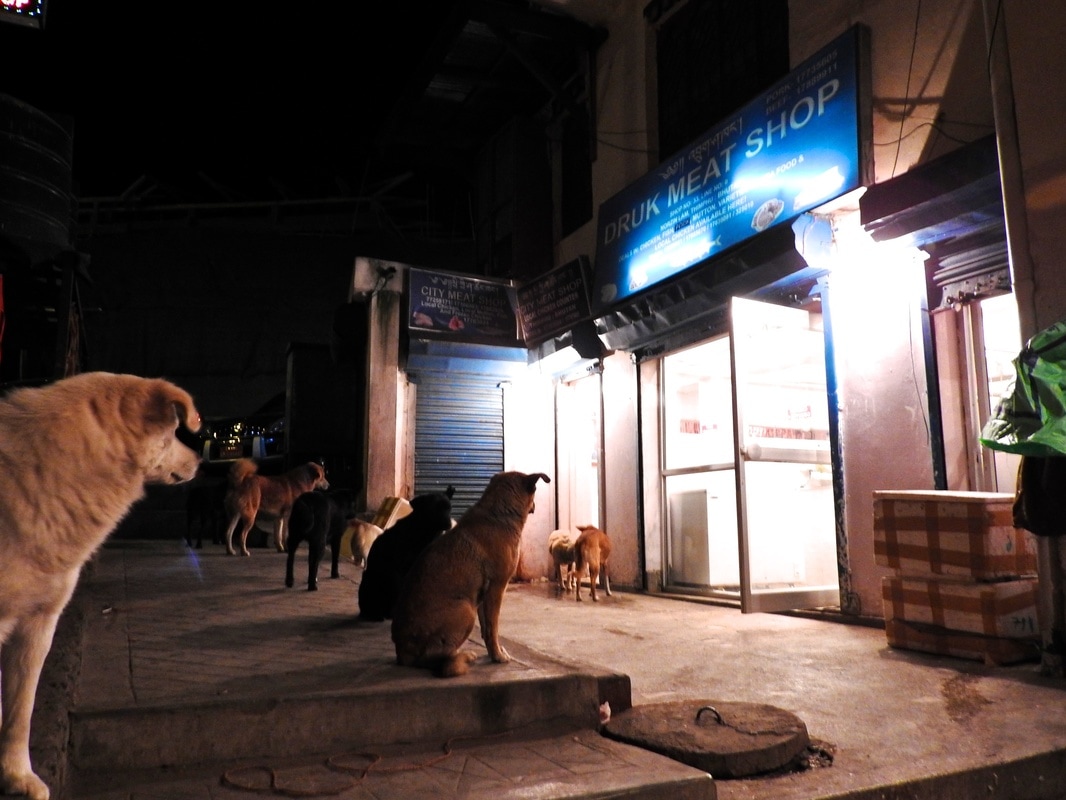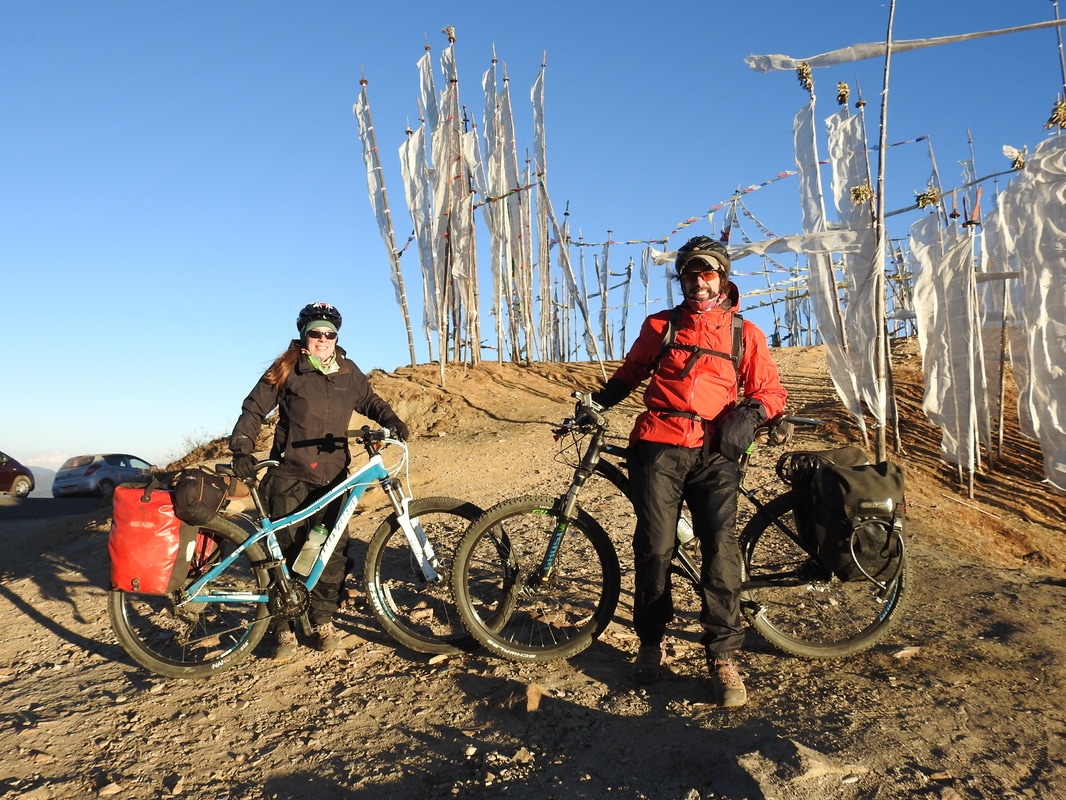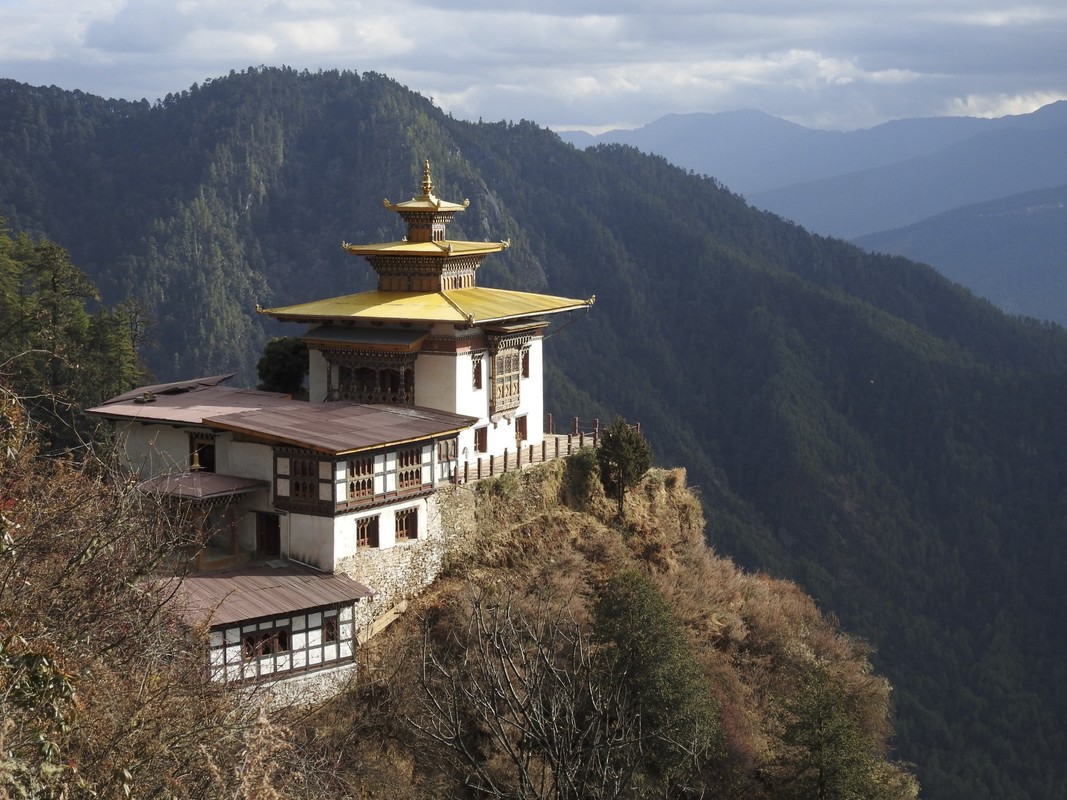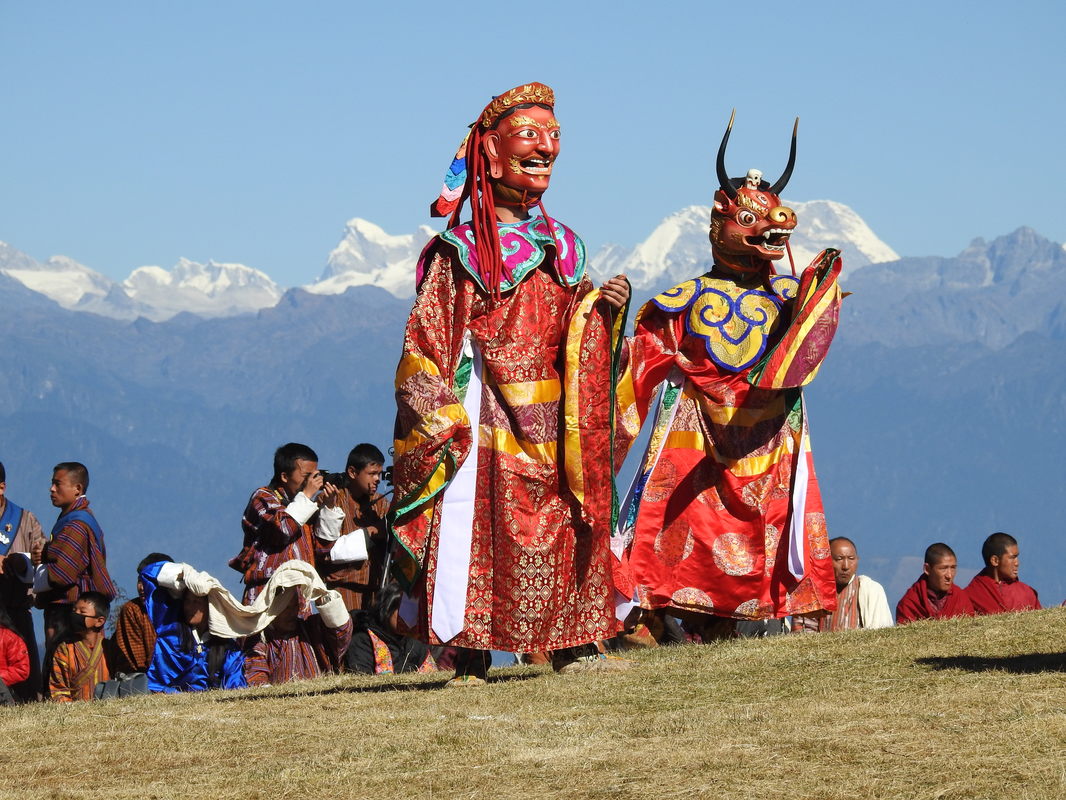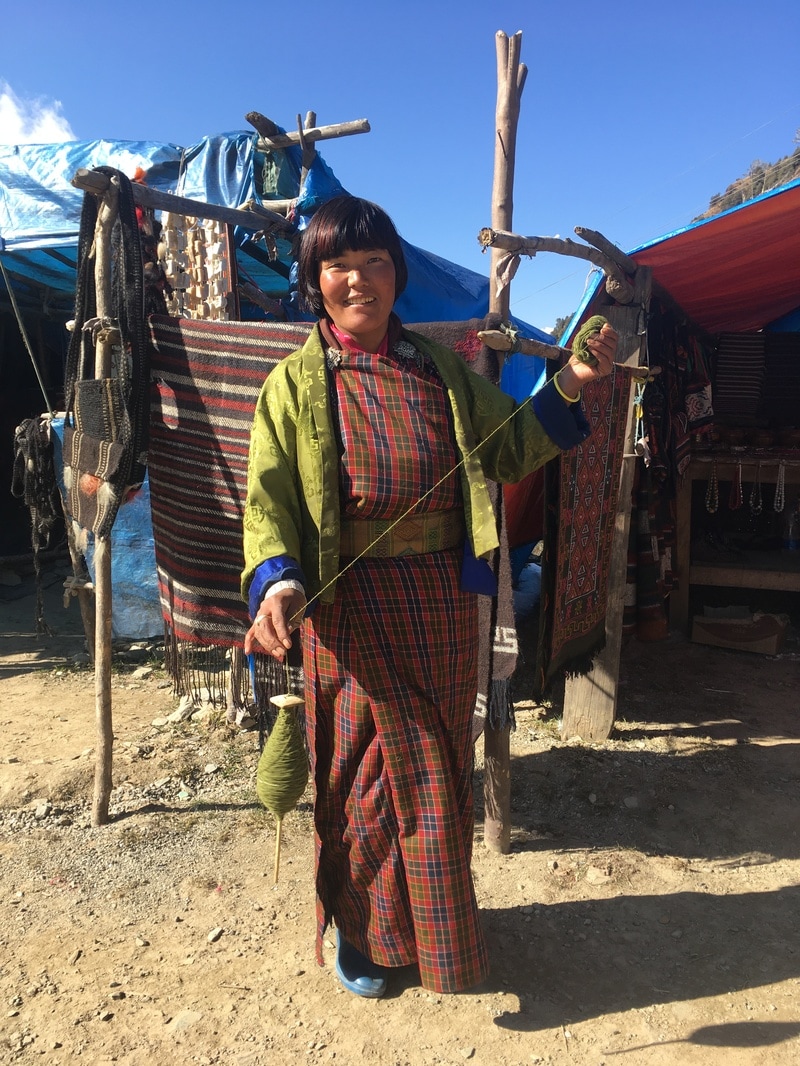
After a few days of taking care of travel logistics in Thimphu, we were ready to take on the most intensive cycling section of our trip. We pedaled up to Dochu La for the second time, with the mountain panorama mostly enshrouded in clouds this time. Then we bundled up for the descent down the other side to Punakha, a fun ride on a freshly paved double-laned road, perhaps the most completed section of the ongoing effort to widen the entire East-West Highway.
However, we were far from finished climbing for the day, since we managed to select a homestay in a village high above the valley floor. We called our host, Aum Leki, at the turn off to begin the ascent and estimated it would take us an hour to reach her farmstead. She informed us that a monk would be waiting for us on the side of the road since it would be difficult to find her house on our own. One hour turned in to two hours, and after gaining about 2,500 feet, we finally saw a cell phone light illuminating the outline of crimson robes in the darkness. We apologized to the monk, who was Aum Leki’s neighbor, for the long roadside wait, but Sonam responded that he simply used the time to conduct his evening prayers and immediately launched in to the specifics of US politics until we reached his house. Then Aum Leki’s father-in-law took over escorting us down the rough dirt road to their house, unnecessarily grabbing on to my bike to “help” me walk it along. With only partial control it was a bit difficult to keep the bike steady with the weight of the panniers on the back rack, but he was quite determined not to let go.
Aum Leki was quite relieved to see us arrive and per Bhutanese custom, we immediately sat down in the altar room for tea, snacks, and welcome pours of ara. We were soon joined by a guide, Chencho, and his Australian client, Pete, both of whom we had met in the Bhutan Swallowtail office in Thimphu a couple of days before. At first we were a little put off by the “hotelness” of our room, but as soon as we realized our attached bathroom had a piping hot shower, all misgivings of lack of authenticity were somehow forgotten. After cleaning up from our long day of cycling, we headed over to the kitchen and sat on cushions around the bukhari to eat a typical Bhutanese dinner of red rice, ema datsi (chilies in cheese sauce), dal (blended lentil soup), and bitter gourd and finished up with a few more cups of ara before heading off for an early bedtime.
The next morning we bid farewell to Pete and Chencho and sat outside on a sunny patio with lovely views of the valley for a late leisurely breakfast. The lower elevation of Punakha made it feel semi-tropical with roses blooming in the garden and citrus ripening on the trees. We walked around the property and met Aum Leki’s “pet” wild boar kept in a tiny enclosure, which she caught in her fields as a boarlet. Apparently the boar is a picky eater and only eats rice, so she wants to give it away, but not to anyone who will eat it. Looks like she will be keeping it for a while…
Aum Leki took us on a short hike to Norbugang village, the home of the four Queen Mothers. We passed by their Royal Palace where preparations were underway to celebrate the first birthday of the Gyalsey (the Crown Prince) on February 5th. Then we met a Forestry Officer returning from a wood use inspection, and he invited to his house for tea. It was getting late in the afternoon by the time we began walking again and we were ready to chill back at the farm, but for some unknown reason Aum Leki seemed to really want us to see her daughter’s school, so we kept going. The students were on winter break, but we explored the grounds and met the friendly principal while he was washing his car in the driveway.
Meanwhile, the father-in-law had been preparing a hot stone bath for us, and indeed the third one of the trip was also a charm. It was one big tub sunken in to the ground enclosed in a wooden hut, but the open doorway allowed partial valley views. This time I overdid it asking for hot rocks, so we spent about as much time out of the tub cooling off as we did soaking, but it still worked wonders on our sore muscles from our ride the day before. After we were finished, their friends came over to enjoy the bath while dinner in the kitchen was a similar affair as the night before, this time with the addition of some fresh curd that Aum Leki had picked up at a neighbor’s on the way back from our walk.
However, we were far from finished climbing for the day, since we managed to select a homestay in a village high above the valley floor. We called our host, Aum Leki, at the turn off to begin the ascent and estimated it would take us an hour to reach her farmstead. She informed us that a monk would be waiting for us on the side of the road since it would be difficult to find her house on our own. One hour turned in to two hours, and after gaining about 2,500 feet, we finally saw a cell phone light illuminating the outline of crimson robes in the darkness. We apologized to the monk, who was Aum Leki’s neighbor, for the long roadside wait, but Sonam responded that he simply used the time to conduct his evening prayers and immediately launched in to the specifics of US politics until we reached his house. Then Aum Leki’s father-in-law took over escorting us down the rough dirt road to their house, unnecessarily grabbing on to my bike to “help” me walk it along. With only partial control it was a bit difficult to keep the bike steady with the weight of the panniers on the back rack, but he was quite determined not to let go.
Aum Leki was quite relieved to see us arrive and per Bhutanese custom, we immediately sat down in the altar room for tea, snacks, and welcome pours of ara. We were soon joined by a guide, Chencho, and his Australian client, Pete, both of whom we had met in the Bhutan Swallowtail office in Thimphu a couple of days before. At first we were a little put off by the “hotelness” of our room, but as soon as we realized our attached bathroom had a piping hot shower, all misgivings of lack of authenticity were somehow forgotten. After cleaning up from our long day of cycling, we headed over to the kitchen and sat on cushions around the bukhari to eat a typical Bhutanese dinner of red rice, ema datsi (chilies in cheese sauce), dal (blended lentil soup), and bitter gourd and finished up with a few more cups of ara before heading off for an early bedtime.
The next morning we bid farewell to Pete and Chencho and sat outside on a sunny patio with lovely views of the valley for a late leisurely breakfast. The lower elevation of Punakha made it feel semi-tropical with roses blooming in the garden and citrus ripening on the trees. We walked around the property and met Aum Leki’s “pet” wild boar kept in a tiny enclosure, which she caught in her fields as a boarlet. Apparently the boar is a picky eater and only eats rice, so she wants to give it away, but not to anyone who will eat it. Looks like she will be keeping it for a while…
Aum Leki took us on a short hike to Norbugang village, the home of the four Queen Mothers. We passed by their Royal Palace where preparations were underway to celebrate the first birthday of the Gyalsey (the Crown Prince) on February 5th. Then we met a Forestry Officer returning from a wood use inspection, and he invited to his house for tea. It was getting late in the afternoon by the time we began walking again and we were ready to chill back at the farm, but for some unknown reason Aum Leki seemed to really want us to see her daughter’s school, so we kept going. The students were on winter break, but we explored the grounds and met the friendly principal while he was washing his car in the driveway.
Meanwhile, the father-in-law had been preparing a hot stone bath for us, and indeed the third one of the trip was also a charm. It was one big tub sunken in to the ground enclosed in a wooden hut, but the open doorway allowed partial valley views. This time I overdid it asking for hot rocks, so we spent about as much time out of the tub cooling off as we did soaking, but it still worked wonders on our sore muscles from our ride the day before. After we were finished, their friends came over to enjoy the bath while dinner in the kitchen was a similar affair as the night before, this time with the addition of some fresh curd that Aum Leki had picked up at a neighbor’s on the way back from our walk.
The following morning, I bought one of Aum Leki’s weavings as a way to remember her sweetness, then got going on the epic day we had plotted out for ourselves. We zoomed down to the floor of the valley and crossed the river, rejoining the National Highway at Bajo. The reality of cycling through the road widening work hit us hard with a very dusty and loose gravel section right off the bat. Fortunately, as we slowly progressed up toward our next pass of Pele La, the road substrate improved even if the dust levels did not. Matt had developed an energy-zapping cough that was further aggravated by the cold temperature and road dust, so it became a struggle to reach the only lodging we knew of, a simple guesthouse a few miles below the pass. We rolled in around 7pm, tired and hungry, and grabbed one of the frigid rooms above the restaurant. After snarfing down rice, kewa datsi (potatoes and chilies in cheese sauce), and dried beef curry, we brought a bucket of hot water from the kitchen up to the bathroom since the pipes were frozen, then crashed in our sleeping bag on top of the bed, both for warmth and the fact that it was obvious the sheets had not been changed for quite some time. We know this because there were little pieces of chewed doma (betelnut) and stains of its characteristic red spit when we pulled back the covers, as well as a forgotten flashlight.
We got a fresh start on tackling Pele La the next morning, taking about two more hours to reach the top and having gained about 7,000 feet of elevation since leaving Punakha Valley the day before. With not much to see at the pass except a chorten and some souvenir stalls, we did not linger and began our hard-earned ride down towards Trongsa. It took most of the day to reach a famous viewpoint of the Trongsa Dzong at roughly the same elevation across the valley, so close but still so far away. We were reminded of cycling along the fjords of Iceland, as we had to descend all the way down to a river cutting through the back end of a side valley and ride all the way back up the other side to actually reach the spot we had gazed upon a few hours before.
The road dust had turned to mud in the side valley excursion, so we arrived to the wonderful Tashi Ninjay Guesthouse in a sorry state of cleanliness. The lovely staff were not phased in the least and gave us a great room with a balcony overlooking the massive, stately dzong brightly lit up in the night.
We got a fresh start on tackling Pele La the next morning, taking about two more hours to reach the top and having gained about 7,000 feet of elevation since leaving Punakha Valley the day before. With not much to see at the pass except a chorten and some souvenir stalls, we did not linger and began our hard-earned ride down towards Trongsa. It took most of the day to reach a famous viewpoint of the Trongsa Dzong at roughly the same elevation across the valley, so close but still so far away. We were reminded of cycling along the fjords of Iceland, as we had to descend all the way down to a river cutting through the back end of a side valley and ride all the way back up the other side to actually reach the spot we had gazed upon a few hours before.
The road dust had turned to mud in the side valley excursion, so we arrived to the wonderful Tashi Ninjay Guesthouse in a sorry state of cleanliness. The lovely staff were not phased in the least and gave us a great room with a balcony overlooking the massive, stately dzong brightly lit up in the night.
Purely by luck, we arrived to Trongsa midway through a multi-day tshechu (Buddhist festival) held in the courtyard of the dzong. We decided to stay an extra day to attend the remainder of it, as well as to let Matt recuperate. Pushing through his sickness for two big days of cycling had definitely caught up to him. Having observed several tshechus already, this one felt familiar, but also had a few dances that we had not seen before. Much like visiting Bhutan’s monasteries, there is a high degree of commonality between tshechus, but each provides a unique experience created by the setting, the local community in attendance, and paying attention to the details of the costumes and the dancing.
Matt rested up in the afternoon, while I watched until the end of the cham (sacred masked dance) performances. In the evening, we wandered through a temporary tent city of restaurants and karaoke bars that had popped up for the festival. We cozied up next to the bukhari in a particularly inviting tent for some momos (dumpings) and beers, trying not to be too obviously intrigued with a group of monks who were fully participating in the drunken revelry surrounding us.
The last day of the tshechu displayed a thondrol, a beautifully embroidered multi-storey tapestry featuring Guru Rinpoche, a great Tibetan saint that liberated many parts of Bhutan from demons. The thondrol is believed to be able to remove one’s sins upon sight. It is only unfurled once per year at daybreak, and while we were still snoring away at that point, we did make it to the courtyard before it was rolled up again. Semi-organized, or perhaps semi-chaotic, lines had formed in the courtyard to pass by the base of the thondrol and underneath a statue of Zhabdrung Ngawang Ngamyel, Bhutan’s unifier, to receive a blessing. We skipped the wait for the blessing and instead did some fascinating people watching from a balcony overlooking the entire courtyard.
Unfortunately, the person who most captivated our attention was a chilip in a bright green jacket and a camera with a tremendously long lens. He seemed to think that his camera gave him absolute entitlement to walk anywhere he pleased at any time and point it at anyone he felt like with any prior permission or interaction. He would stand in front of others and block their view, then walk across the dance floor in the middle of a performance for a new angle. With the lens he had, there was really no need to do either. Even if he was a legit professional, which somehow we highly doubted, his behavior made us cringe, yet we did not have the willpower to ignore him and gave in to watching his every annoying move.
After we had done our own more discreet documenting, we took our leave from the tshechu and spent the remainder of the day cleaning off our bikes, hand washing some laundry, sorting out gear, and shopping for an immanent two-week diversion from the cycle tour to explore the little-visited southern district of Zhemgang the least developed dzongkhag of Bhutan.
Matt rested up in the afternoon, while I watched until the end of the cham (sacred masked dance) performances. In the evening, we wandered through a temporary tent city of restaurants and karaoke bars that had popped up for the festival. We cozied up next to the bukhari in a particularly inviting tent for some momos (dumpings) and beers, trying not to be too obviously intrigued with a group of monks who were fully participating in the drunken revelry surrounding us.
The last day of the tshechu displayed a thondrol, a beautifully embroidered multi-storey tapestry featuring Guru Rinpoche, a great Tibetan saint that liberated many parts of Bhutan from demons. The thondrol is believed to be able to remove one’s sins upon sight. It is only unfurled once per year at daybreak, and while we were still snoring away at that point, we did make it to the courtyard before it was rolled up again. Semi-organized, or perhaps semi-chaotic, lines had formed in the courtyard to pass by the base of the thondrol and underneath a statue of Zhabdrung Ngawang Ngamyel, Bhutan’s unifier, to receive a blessing. We skipped the wait for the blessing and instead did some fascinating people watching from a balcony overlooking the entire courtyard.
Unfortunately, the person who most captivated our attention was a chilip in a bright green jacket and a camera with a tremendously long lens. He seemed to think that his camera gave him absolute entitlement to walk anywhere he pleased at any time and point it at anyone he felt like with any prior permission or interaction. He would stand in front of others and block their view, then walk across the dance floor in the middle of a performance for a new angle. With the lens he had, there was really no need to do either. Even if he was a legit professional, which somehow we highly doubted, his behavior made us cringe, yet we did not have the willpower to ignore him and gave in to watching his every annoying move.
After we had done our own more discreet documenting, we took our leave from the tshechu and spent the remainder of the day cleaning off our bikes, hand washing some laundry, sorting out gear, and shopping for an immanent two-week diversion from the cycle tour to explore the little-visited southern district of Zhemgang the least developed dzongkhag of Bhutan.

